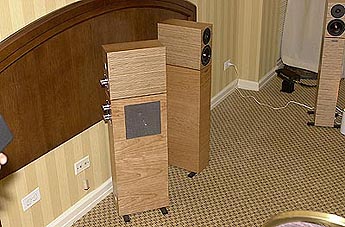 |
|||||||||||||
|
Sometimes we are proud of our Dutch heritage (and often we are not). The GTT Audio room with a Walker Audio Proscenium Gold turntable and hardwired phonostage plus a Lamm pre and power amplifiers suspended on Cloud 10s drove not just a pair of Kharma 3.2 FE speakers but also the new Kharma Ceramique subwoofer. Properly set up as we are used to from previous GTT previous encounters, the sub disappeared completely and merely added an extra dimension to the overall soundscape to make us feel great about being Dutch for a change. |
|||||||||||||
 |
|||||||||||||
| on the benefits of this bigger-is-badder concept. With the big video screen in the room, we should have been forewarned. Alas, we had already swallowed the bait. Speakers were everywhere in this small room. The guy who'd invited us in started his conversion speech by referring to the fact that ordinary multi-channel systems simply do not have sufficient power to meet the demands of the cinematographers. For special effects, a system needs far more power. Fifteen-inch subwoofers, a myriad of smaller woofers, a couple of thousand watts and the stupidest movie ever all were let loose on a small Hilton hotel room and us. Even after successfully pleading with him to turn the volume down, we couldn't stomach this cacophony and fled the crime scene bloodied. |
|||||||||||||
A few rooms down the hall Portal Audio demoed with the Finnish Penaudio Charisma loudspeakers combined with the newly decorated Chara subwoofers. Here was another room that played music. The small and friendly looking loudspeakers produced a far bigger sound than expected from the size. Even though the already mentioned deafe-ning neighbors pestered the room, it was a sanctuary. We make our living in IT and technology, one reason for why a rack of folders in the hallway attracted our attention next. One of the folders read "Image AnyPlace Video Pro-cessor". That nearly recalled SciFi images of pilots with |
|||||||||||||
 |
|||||||||||||
| information displays on their curved cockpit window or inside a helmet visor. Silicon Optix has developed a chip that enables extreme vertical and horizontal angle keystone correction. When this chip is used in a video processor/scaler and connected to the video projector, it is possible to place the projector almost anywhere in the room and still obtain a perfect image. With this technology, it is no longer necessary to have the projector situated perpendicular to and in the middle of the screen. Bolt the beamer into the right hand upper corner of the room and the image will still be picture-perfect as long as there are no physical obstructions to the light beam. Even projecting onto a curved wall is no longer a problem. The room next door was home to Reimyo by Combak/Harmonix and the sound, atmosphere and musicality made it ex equo to the Rhapsody exhibit. This was a room to stay in for extended periods to soak in the healing effects of music. The benign presence radiated by Kiuchi-San was perhaps the ultimate tuning of this Reimyo system. What we heard here was truly a miracle. The word Reimyo -- miracle in Japanese -- was thus aptly chosen. . |
|||||||||||||
 |
|||||||||||||
Now staying far away from any room with screens, we went down the stairs to the fourth floor where Sally Ladd and Bob Visintainer hosted their second room. For fun and games and to break the sometimes overly heavy seriousness of "high end", Jeff Joseph let us listeners believe we were listening to a pair of his new Joseph Audio RM55s but he later revealed the new Insider loudspeakers as the actual sources of sound. For in-wall loudspeakers of this size, the Insider really did a remarkable job. Pure nostalgia could then be found in the concourse where Vladimir and Elena Lamm shlepped a pair of giant Siemens Klangfilm Bionor cinema speakers into the ball |
|||||||||||||
 |
|||||||||||||
| room. Every time Vladimir sets up these hard-to-ship monstrous horns, the sound is amazing. Best of all, the setup is | |||||||||||||
| without a screen so you can create the image yourself. In the end, our (predetermined?) choice of visiting HE 2004 worked out well. We just hope that like at the HVT show, show management will in the future separate audio from video. How about using the two higher floors for pure audio and the fourth floor for video? And including video games to the fourth floor would undoubtedly attract a younger crowd as well while 'old fogies' like us can congregate in the loftier realms of the upper floors. |
|||||||||||||
 |
|||||||||||||
 |
|||||||||||||
 |
|||||||||||||
 |
|||||||||||||